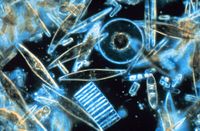
Photo from wikipedia
The Troodos ophiolite Cyprus hosts the on-land analogue for actively forming mafic, Cu-rich, or Cyprus-type VMS deposits. In addition to high-temperature (> 350 °C) sulfide mound-related mineralization, other fossil seafloor mineralizing systems… Click to show full abstract
The Troodos ophiolite Cyprus hosts the on-land analogue for actively forming mafic, Cu-rich, or Cyprus-type VMS deposits. In addition to high-temperature (> 350 °C) sulfide mound-related mineralization, other fossil seafloor mineralizing systems are known to operate, including those characterized by an enrichment in Au and abundant silicification. In this study the mineralogy and geochemistry of four Au and silica-rich localities in Troodos are considered, and these include Kokkinovounaros, Mathiatis South, Touronjia, and Alpen Rose. We present whole rock geochemical and mineralogical data characterizing the distribution of Au in the hydrothermal systems of Troodos. Samples from silica-rich localities have two distinct sample mineralogies: supergene samples that contain predominantly goethite, hematite, and jarosite and hypogene samples that contain quartz, amorphous silica and minor hematite. Hypogene samples from Mathiatis South and Kokkinovounaros are enriched in Au with a median concentration of 1.5 ppm relative to supergene samples that contain 0.1 ppm ( n = 107). This indicates that Au enrichment occurred on the seafloor and is not solely related to supergene weathering of silica-rich mineralization. We suggest that silica-rich Au mineralization in Troodos formed during the migration of newly formed crust off-axis or as white smokers proximal to known VMS deposits. In silica-rich mineralization that is located distally from known massive sulfide deposits, Au was probably remobilized from shallow crustal reservoirs during the low-temperature fluid flow (100–300 °C) in the lower extrusive sequence as the crust cooled and migrated off-axis. Based on modern seafloor analogues, we propose a revised model for the Troodos hydrothermal system that explains the distribution of Au in silica-rich mineralization that formed off-axis and postdates VMS formation and in zones proximal to VMS deposits that formed simultaneously as white smoker-type vents. We suggest that silica-rich mineralized zones formed an intermediary between high-temperature (> 350 °C) on-axis VMS deposits and the low-temperature silicification of umbers (< 100 °C).
Journal Title: Mineralium Deposita
Year Published: 2020
Link to full text (if available)
Share on Social Media: Sign Up to like & get
recommendations!